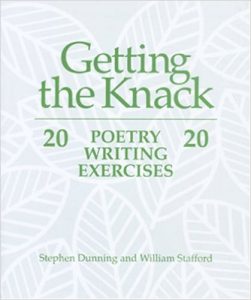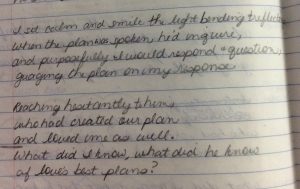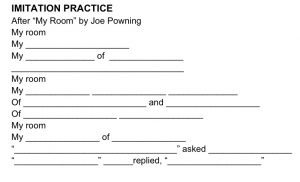Spring is one of my favorite times of year. Everything is in bloom. People are friendlier. There’s a certain renewal that the season brings.
And that’s why after a long day of teaching, I often hit the woods.

Here’s where I started to obsessively take tree pictures. Just imagine me gushing at the crisp blue and billowing clouds.

And here’s where I got scared of cranes blocking the trail. (They seemed rather territorial.) Initially, I started this hike pounding the ground. After all, I had to take this rare opportunity for exercise.
But the trail didn’t want this of me, and the cranes made sure of this. So I turned around, allowing my walk to be diverted by cranes.
After my detour, my mind started to soften and release the tension from the day.
Hiking slows my thinking down. I get away from the treadmill of my day, and I let my mind “wander lonely as a cloud.” I notice things more–like this bud just waiting to unfurl.

I thought of taking a trail that I realized was too long if I was going to make it to school pick-up. So I started running. And here the trail spoke again: slow down.
And when I slowed down–look what I found!

Baby cranes!!
Suddenly, all the stops and starts were worth it, even if they did lead to some rethinking and rerouting.
Often we meet standoffish cranes in our classrooms. We want to turn away. We want to avoid working with them because they take us out of our comfort zones.
But underneath every standoffish crane is a fluffy little chick who just needs to be gently shepherded.
The cranes I could never quite escape were much like a challenging student; there’s no avoiding either.
Afraid of the cranes no more, I took a wide arc off the trail for a moment and then took a series of baby crane pictures because I just couldn’t help myself (who can?!).
And thanks to the cranes, I even found my way back to my favorite tree!

 Lauren Nizol (@CoachNizol) is an MTSS Student Support Coach and Interventionist at Novi High School. She has eleven years of classroom experience, teaching English, IB Theory of Knowledge and English Lab. Lauren completed her undergraduate degree in History, English and Secondary Education at the University of Michigan-Dearborn and her Masters in English Education from Eastern Michigan University. She is a National Writing Project Teacher Consultant with the Eastern Michigan Writing Project and an advocate for underperforming students and literacy interventions. When she’s not teaching, Lauren often runs for the woods with her husband and their three sons/Jedi in training and posts many stylized pictures of trees on Instagram.
Lauren Nizol (@CoachNizol) is an MTSS Student Support Coach and Interventionist at Novi High School. She has eleven years of classroom experience, teaching English, IB Theory of Knowledge and English Lab. Lauren completed her undergraduate degree in History, English and Secondary Education at the University of Michigan-Dearborn and her Masters in English Education from Eastern Michigan University. She is a National Writing Project Teacher Consultant with the Eastern Michigan Writing Project and an advocate for underperforming students and literacy interventions. When she’s not teaching, Lauren often runs for the woods with her husband and their three sons/Jedi in training and posts many stylized pictures of trees on Instagram.


 Michael Ziegler (
Michael Ziegler (
 Hattie Maguire (
Hattie Maguire ( As a 5th grade teacher, I would always have students moan, eyeroll, and state either dramatically or smugly, “I’ve read that book,” when I would pull out
As a 5th grade teacher, I would always have students moan, eyeroll, and state either dramatically or smugly, “I’ve read that book,” when I would pull out  Beth Rogers (
Beth Rogers (
 Writing instruction has become my favorite part of teaching, though it didn’t always come easily. In the beginning, my own writing was stilted in structure and lacked voice. I wrote what I had been taught, which was a five paragraph essay and a five sentence paragraph. Not only was my writing boring. The moves I made to create it were not defined enough for students to use as models, except for stilted, formulaic writing that also lacked voice and a sense of ownership.
Writing instruction has become my favorite part of teaching, though it didn’t always come easily. In the beginning, my own writing was stilted in structure and lacked voice. I wrote what I had been taught, which was a five paragraph essay and a five sentence paragraph. Not only was my writing boring. The moves I made to create it were not defined enough for students to use as models, except for stilted, formulaic writing that also lacked voice and a sense of ownership. Amy Gurney (
Amy Gurney (


 Rick Joseph (
Rick Joseph (